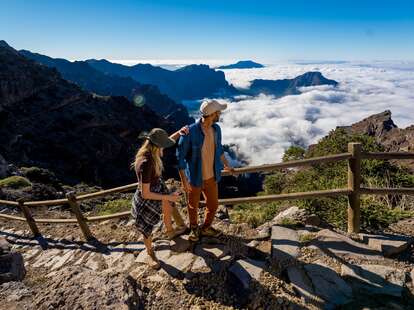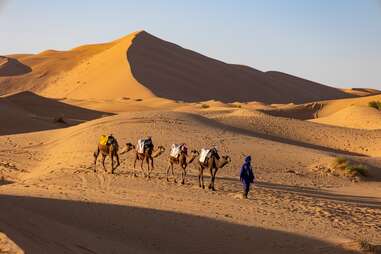
These Gorgeous, Warm Islands Are Europe’s Best Secret Winter Escape
Deserts next to tropical forests next to volcanoes next to tidal pools.
Spain, with its mild Mediterranean climate, sweeping beaches, buzzing nightlife, and fantastic food—may seem like the obvious choice for a holiday escape in Europe. But unfortunately, wintertime still means winter weather on the Iberian peninsula.
Don't despair—there's a warm getaway the Spaniards guard secret: the Canary Islands. Just off the coast of northern Africa, this Spanish archipelago has a subtropical climate that guarantees temps around 70 to 73 degrees throughout January and February. The eight islands comprising the Canaries even receive the most sunlight out of any other spot in Europe—no wonder they’re nicknamed "the lucky islands."

Tenerife and Gran Canaria are the largest (and perhaps most touristy), with a wide range of landscapes and activities, from whale-watching to hiking. Lanzarote and Fuerteventura are laden with lava fields and volcanoes, Greek-style whitewashed homes, and white-sand beaches with spectacular surfing. And La Palma, La Gomera, El Hierro, and La Graciosa are the smallest, with fewer people but plenty of lush, green forests and mountainous treks.
Here, you can opt between laid back-lounging and adventuring in the black and ochre volcanic landscapes, martian-like panoramas of arches and slot canyons, and colorful, colonial-style villages lining the hills. You can ride camels from sandy dunes studded with cacti, hike to waterfalls surrounded by tropical palms, or swim next to seahorses in the most transparent of water.
If you need more reasons to add the Canaries to your list of winter locales, here are a few.

Feel like you’re in space with moon-like landscapes and the brightest stars
At 12,198 feet, Teide on Tenerife is the third tallest volcano in the world. For those who summit its peak, the views above the clouds are simply stunning, but even trekking below on the otherworldly grounds of Teide National Park will make you feel like an astronaut.
The altitude, low level of light pollution, and frequent winds that keep the sky clear make Teide an exceptional destination for stargazing, which is why astrophysicists from all over the world flock to the Teide Astronomic Observatory. Joining a night sky observation tour like Astrophototour or Tiede by Night is almost mandatory.
The feeling like you’re on the moon goes even further at Timanfaya National Park on Lanzarote island, with its rough, barren, and rocky surface. Vineyards unlike anywhere else on the planet grow on Lanzarote in black, volcanic soil within crater-shaped pockets, as though hit by a group of asteroids ages ago. (El Grifo, which has produced wine for more than 250 years, is the oldest in the Canaries and fifth-oldest in Spain.) Seeing such unexpected life—combined with a recent volcano eruption in Las Palmas that has affected most of the island’s surface—you almost can’t help but admire the tenacity of the local islanders living around all the volcanic activity.

Ride a camel from the desert to the jungle to the ocean to the city
It’s not all arid, red expanses in the Canaries. The islands are also full of subtropical wet forests, mist-covered mountains, endemic fauna and flora, fine gold- and black-sand beaches, and saltwater tidal pools as clear as glass right next to the ocean and lined by cliffs like Los Gigantes, on Tenerife.
Adventures here come by way of mother nature: Ride a dromedary (one-humped camel) in the Maspalomas Dunes on Gran Canaria; track down the 1,000-year-old Drago Tree; or take off on waterfall and ocean cliff treks in Charco Azul on Gran Canaria or Cascada de los Tilos on La Palma.
Don’t miss out on visiting villages from different centuries, such as Icod de Los Vinos, Teguise, or La Laguna. Icod is one of the oldest towns on the islands—archaeological remains have been found dating back to the fifth century BCE that belonged to the Guanches, the original inhabitants of Amazigh descent.

Play or lay by the water
Water sports fans and thrill-seekers just hit the jackpot at the Canary Islands. The clear waters and trade winds make them the perfect spot for surfing, kitesurfing, and windsurfing (all the surfing, really). The Canary Islands are also a great destination for whale and dolphin watching, scuba diving, and snorkeling with stingrays, sea horses, and turtles.
Or, take a dip in one of the many charcos, natural, saltwater pools formed along the rocky coastlines. Some of the top spots are Charco del Viento, Charco Los Chochos, and Charco del Faro de Buena Vista, but you can find them all over the island.
On Lanzarote, head to Playa Papagayo’s gorgeous turquoise waters, El Golfo’s black lava pebbles and small green lagoon, or windy and wild Famara. On Fuerteventura, Dunas de Corralejo has nearly six miles of beach coastline surrounded by dunes that have been declared a UNESCO Biosphere Reserve, while Playa de Sotavento de Jandía’s sand creates small, natural pools. Tenerife has Las Teresitas for golden Saharian sand and kid-friendly shallow waters, as well as volcanic black-sand beauty El Benijo. Other favorites: Nogales on La Palma and Playa del Inglés on La Gomera.

Party during a month-long festival
If you are looking for a fiesta, you should consider traveling before Easter: Carnaval de Santa Cruz de Tenerife is the younger sibling of Brazil's Carnival celebrations, complete with salsa music and batucada, street parades, dancing, and a whole lot of color. Watch out for the Queen of the Carnival with her elaborate, architectural, and über-glam feathered costume. (Fun fact: A Queen's dress can weigh anywhere from 330 to 440 pounds.)
The festivities will run the entire month of February in Tenerife, so you have plenty of time to catch the party.

Feast on traditional and fine dining fare
Canarian cuisine is unembellished and extremely satisfying. How to find it? Try Guachinches, humble family-run restaurants (similar to Italian trattorias) that serve simple, filling dishes for a reasonable price. The best of these restaurants are modest, no-name joints, so wander at your leisure and discover local dishes.
Papas arrugadas (or “wrinkled” potatoes) with mojo verde (cilantro-based sauce) or mojo rojo (chili-garlic sauce) is definitely a must-try. Other local delicacies include almogrote, a sauce crafted from cured goat's cheese and dried peppers; gofio, flour made from toasted grains; and sweet bienmesabe, a dessert prepared with almonds, honey, and egg yolks.
A strong Venezuelan population means you can also find arepas and cachapas on the islands. You can also get ropa vieja (shredded braised beef and vegetables), roasted kid, atún encebollado (tuna smothered in onions), and practically any other fresh fish. Be sure to try some of the volcanic wines, like Malvasía or Tajinaste. And don’t leave without sampling the emblem of the Canary Islands: the sweet and fragrant plátano de Canarias, a small Cavendish banana variety worthy of a protected designation of origin label.
If you are looking for a more sophisticated gastronomic experience, reserve a spot at two Michelin-starred M.B. at The Ritz-Carlton, Abama in Santa Cruz de Tenerife, helmed by renowned Basque chef Martín Berasategi. Or, try one-star La Aquarela in Gran Canaria for a contemporary take on traditional Canarian cuisine.